We surveyed 7392 Americans from all across the States about their experience with Long-Distance Relationships (LDR).
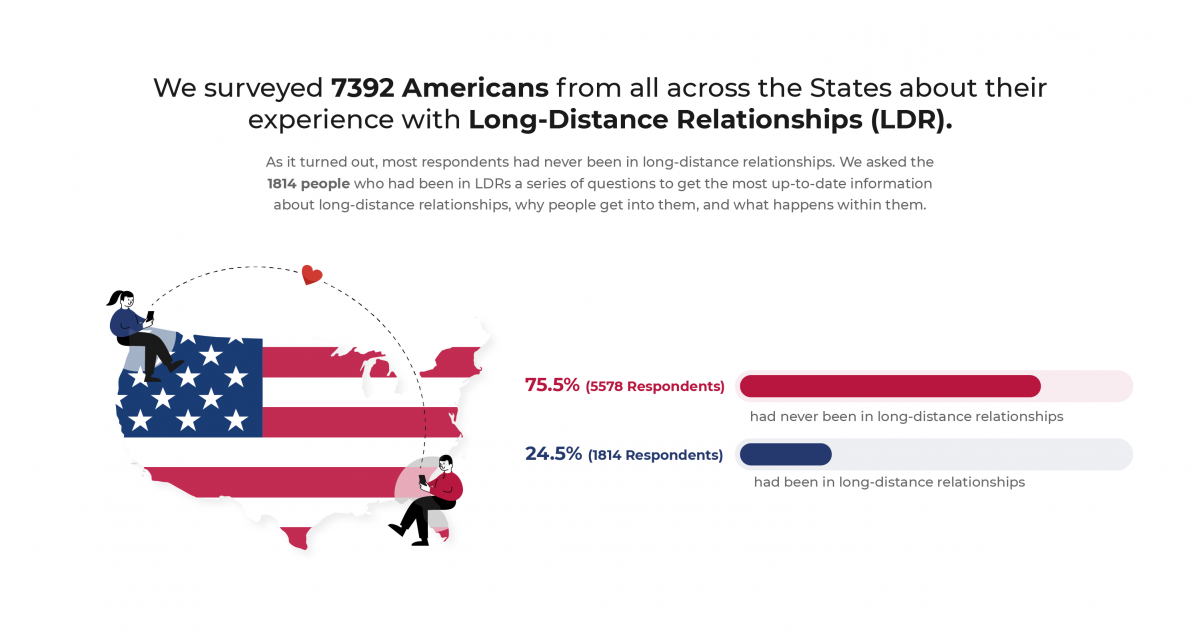
In particular, we wanted to know how many long-distance relationships are successful and what makes them work out (or not).
Here are the highlights of the study:
- 31% of couples have closed the distance. Another 26% have a definite end plan in place to close the distance. That means as many as 57% of LDRs were either successful or close to success.
- 32% of respondents said they wouldn’t choose to be in an LDR again.
- Older people are less optimistic about LDR than younger people – 38% of those over 45s said they wouldn’t be in an LDR again, whereas only 27% of 18-24s said the same.
- People define long-distance relationships differently. 51% of respondents believed long-distance meant living at least 2 hours away, while 50.8% said it meant living in a different state or country. (one person could select several options).
- Cheating was reported in 22% of long-distance relationships (either the respondent or their partner cheated, or both).
- Bad or Not Enough Communication was the biggest reason for LDR failure, with 40.2% of respondents thinking it was important. It got more votes than Jealousy (28.7%) or Cheating (17.5%).
- 5.1% of LDR were open relationships, similar to the general population.
- 8.8% of those aged 65+ had open relationships, more than any other age group and twice as many as 25-34 year-olds (4.4%).
- Couples in LDR who meet more frequently are less likely to cheat. For couples who met once a month, 68% of them were certain no cheating had occurred, compared to 46% of couples who met every 4-6 months.
- 71.2% of respondents said that work or study was the reason they entered into long-distance relationships.
- 50.8% of respondents stated that they lived in an LDR for more than a year.
- 11% of people in LDR have never met in real life, which correlates with the fact that 15% of respondents met online.
- 75.5% of those we asked had never been in a long-distance relationship (out of 7392 US respondents)
Couples In Long-Distance Relationships
The exact number of people in long-distance relationships is hard to ascertain, but many researchers have tried to do just that.
So how many people are in long-distance relationships, and what do they look like? Are there demographic distances?
One source claims that not only are 14 million couples currently in a long-distance relationship (as of 2019), but 75% of engaged couples have been in one at some point during their relationships (Easelly, 2019).1 3 in 4!
Long distance doesn’t always end with marriage, either: 2.9% of married people are still married long-distance (Easelly, 2019).1
Another study by sex toy manufacturer Kiiroo (2018)2 of 1000 people found that 1 in 7 people was in a long-distance relationship of some kind.
Long distance relationships seem to be more prevalent among younger people and students in particular. 34.2% of romantically involved students were in LDRs, and the figure rose even higher for first-year students, anyone in longer duration relationships, and multiracial students (Journal of American College Health, 2021).3
Method
The main goal of our research was to find out how common long-distance relationships are and the opinions of people who have been in them.
We found that existing studies either were outdated or didn’t reveal much about where they got the data, which made us question the viability of the results.
Hence we conducted a representative survey of 7392 Americans asking them, “Are you living or have you ever lived in a long-distance relationship?”
If respondents answered with some version of “yes,” we asked them 9 further questions to learn more about their experiences with long-distance relationships and their opinions. 1,175 responded in the affirmative and were asked the subsequent questions.
All data were collected anonymously using the Google Surveys platform, targeting only Americans. You can access the raw data of the survey here.
Questions included:
- Are you living or have ever lived in long-distance Relationships (*LDR*)?
- How old are you?
- What is necessary to call a relationship long-distance? (You can select several, but pick the most relevant).
- How long are you living (or lived) in a long-distance relationship (LDR)?
- How often do you meet?
- What’s the main reason why you are living (or did live) in LDR?
- Do you plan to close the distance?
- Have you or your partner ever cheated on each other?
- What do you think is the biggest LDR killer, the biggest reason for long-distance relationship failure?
- Do you consider a long-distance relationship a viable long-term solution for you?
Once we had the results, we analyzed the data to find patterns and trends.
Key Findings
What Percent of Long-Distance Relationships Work?
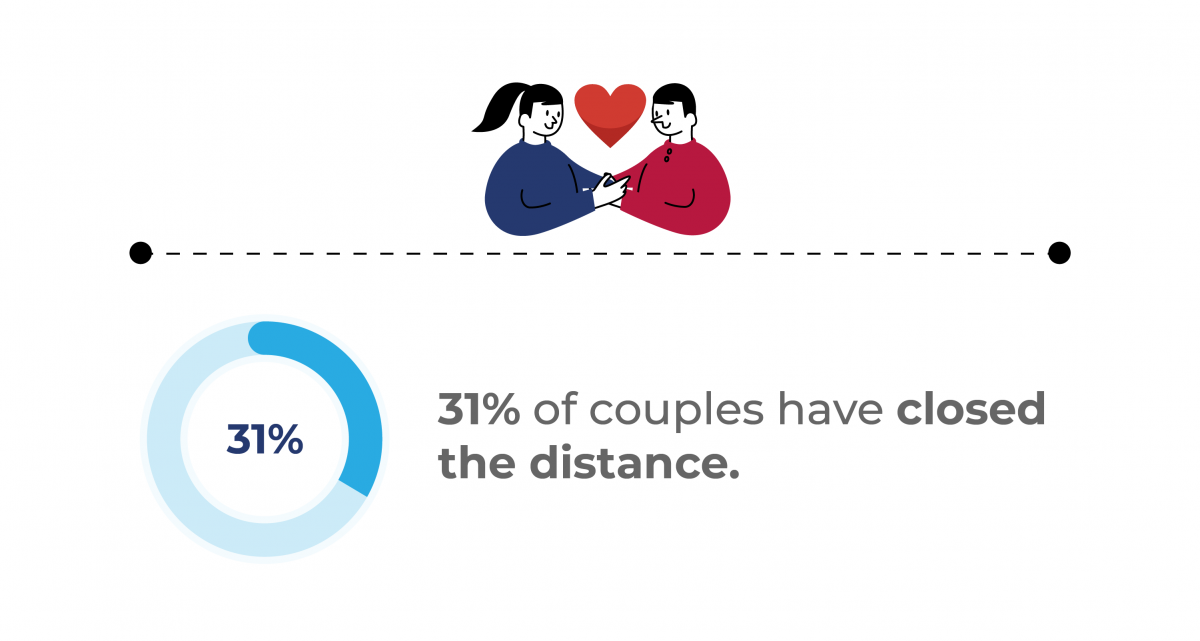
Success in any relationship is hard to measure. Is success celebrating a particular anniversary together? A couple spending their whole lives married together?
For long-distance relationships, there is an easier metric to look at: closing the distance, at which point the long-distance part of the relationship ends. This was how we defined success in long-distance relationships.
One article states that the average length of time for a long-distance couple to move in together is 14 months (Easelly, 2019).1
A 2018 survey conducted by Kiiroo stated that long-distance relationships have a 58% success rate, though they neglect to mention how they define “success rate” (Kiiroo, 2018).2
We found that 31% of responses claimed the respondent had closed the distance already. Moreover, a further 26% stated they either “had a definite end plan in place” or were “engaged or married with a definite end plan.”
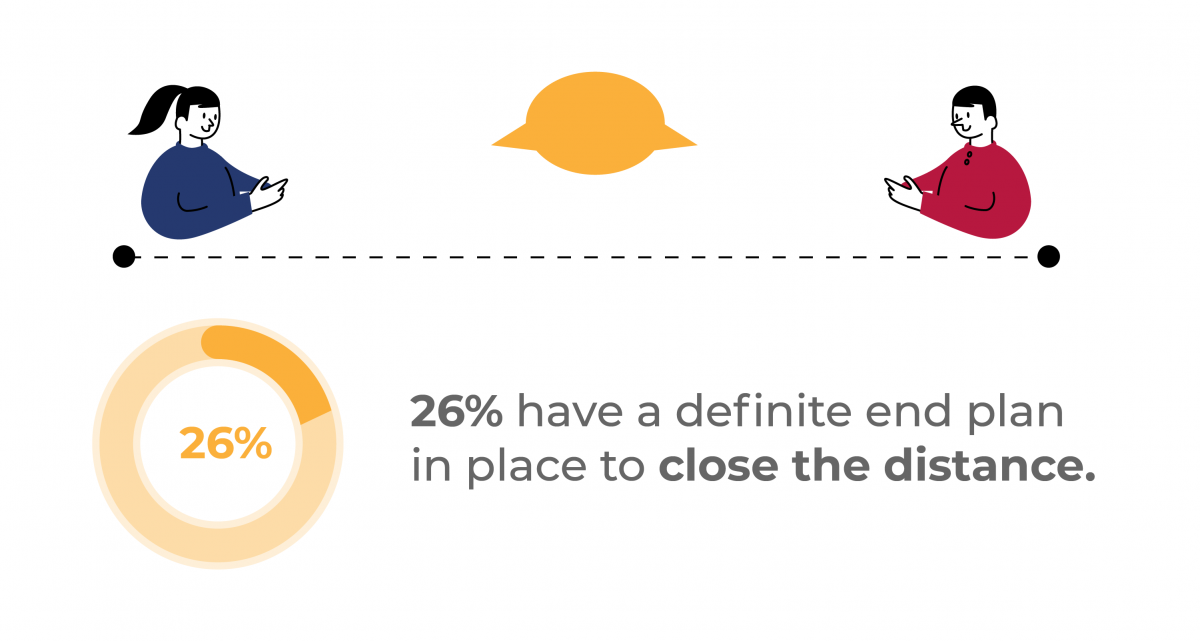
With that in mind, we could say that the success rate of long-distance relationships is somewhere between 31% and 57% since an “end plan” does not automatically constitute success.
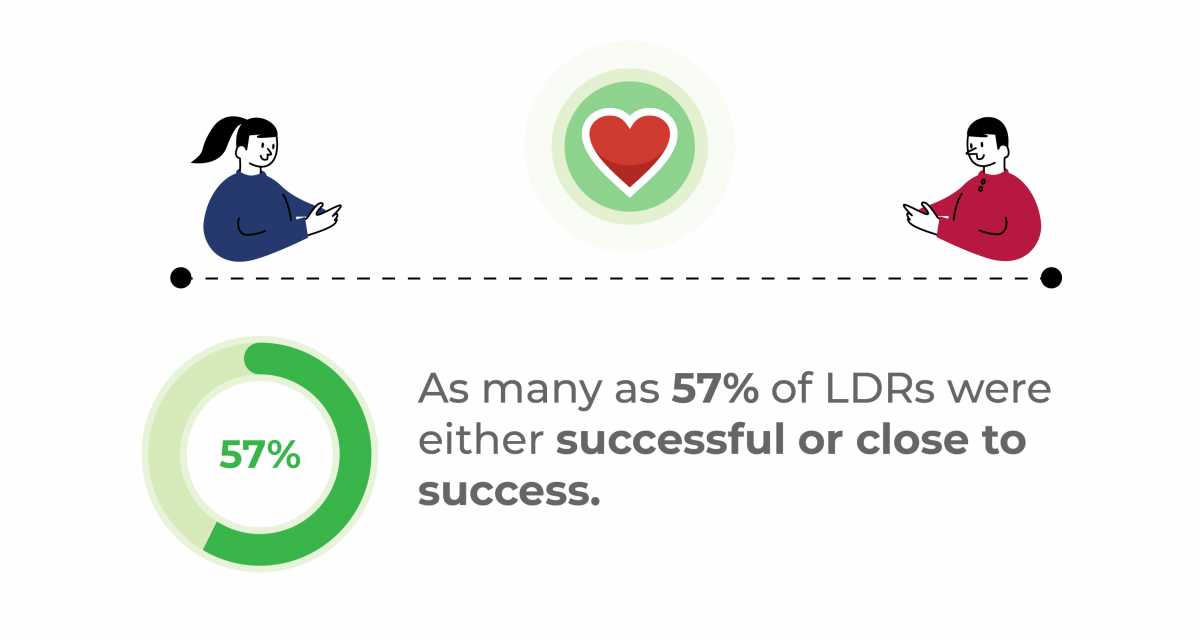
We can compare this to the commonly cited (but probably inaccurate) statistic4 that 40-50% of marriages end in divorce.
Despite the common refrain “long-distance never works out,” it seems that LDRs have comparable chances of success to proximal relationships.
Benefits of Long-Distance Relationships
There appears to be a great deal of doom and gloom around the concept of long-distance relationships, that they exist to be suffered through in order to be granted a reward once the relationship finally closes the distance.
However, there are some oft-overlooked benefits of remaining long-distance for some time.
Patience and perseverance are obvious examples of skills that LDRs will make people acquire. It is difficult to desire instant gratification when your significant other is not around most of the time.
Communication is, of course, a cornerstone of any relationship. Poor communication is cited by many relationship counselors and therapists as the most common reason why marriages don’t last.
Over half of the respondents in one study reported that spending time apart made them feel closer to their partners over the long term, which attests to the importance of good communication (Kiiroo, 2018).2
How Many People Don’t Want to be in a Long-Distance Relationship Again?
Despite the success rate of long-distance relationships, 32% of those surveyed who had been in at least one LDR claimed they did not consider LDR a viable long-term solution.
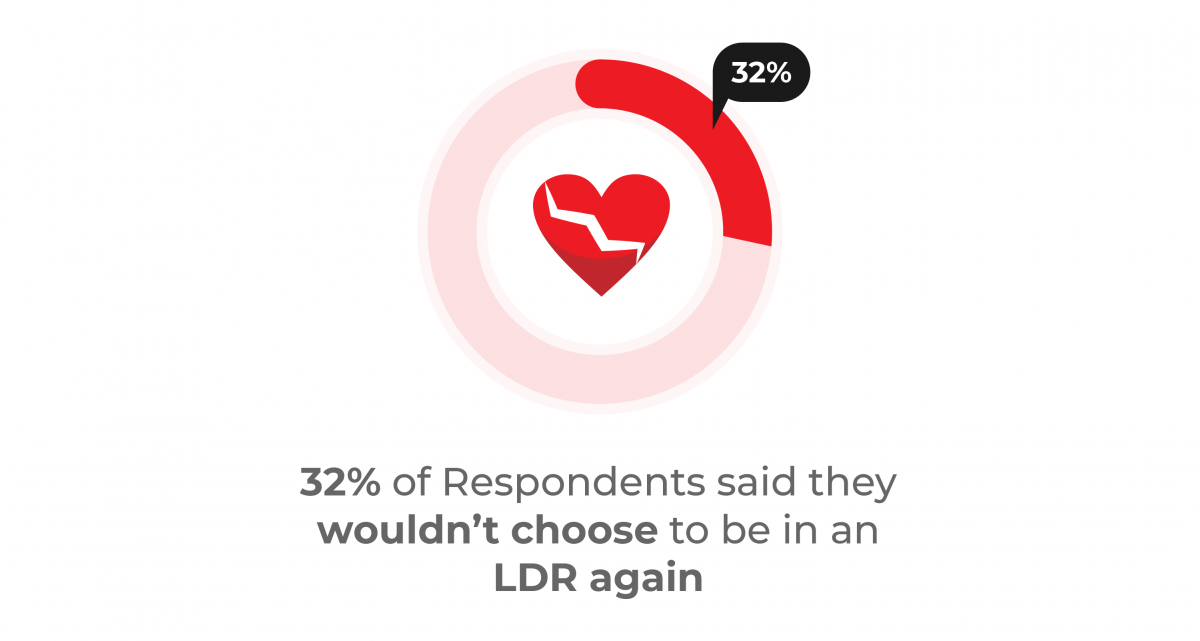
Of those who answered they would not do it again, 59.5% claimed they had broken up with their partners. 28.6% had closed the distance and were (presumably) still with their partners, while 11.8% were still in LDR.
We can take the optimistic view – that these 40.4% of respondents would not do it again because they already found the love of their life – but that still leaves the majority whose relationships failed and left them disillusioned.
It’s rare for someone in a proximal relationship that ends to say they wouldn’t date someone nearby again – despite what Hollywood romcoms might tell you – so a failed long-distance relationship might leave more scars and negativity than breaking it off with someone who lives a few streets away.
Relationships that Begin as Long-Distance
One source claims that 10% of all marriages5 in the US actually started out long-distance, no doubt spurred on by the massive popularity of online dating over the past decade.
Another 2018 survey6 found that 27% of couples had never lived near each other at any time.
There is little to no evidence suggesting that relationships that begin long-distance are any more or less likely to succeed than other kinds of relationships.
Which Age Group Doesn’t Want To Be In A Long-Distance Relationship Again?
38% of over 45s said they wouldn’t be in an LDR again, whereas only 27% of 18-24s said the same.
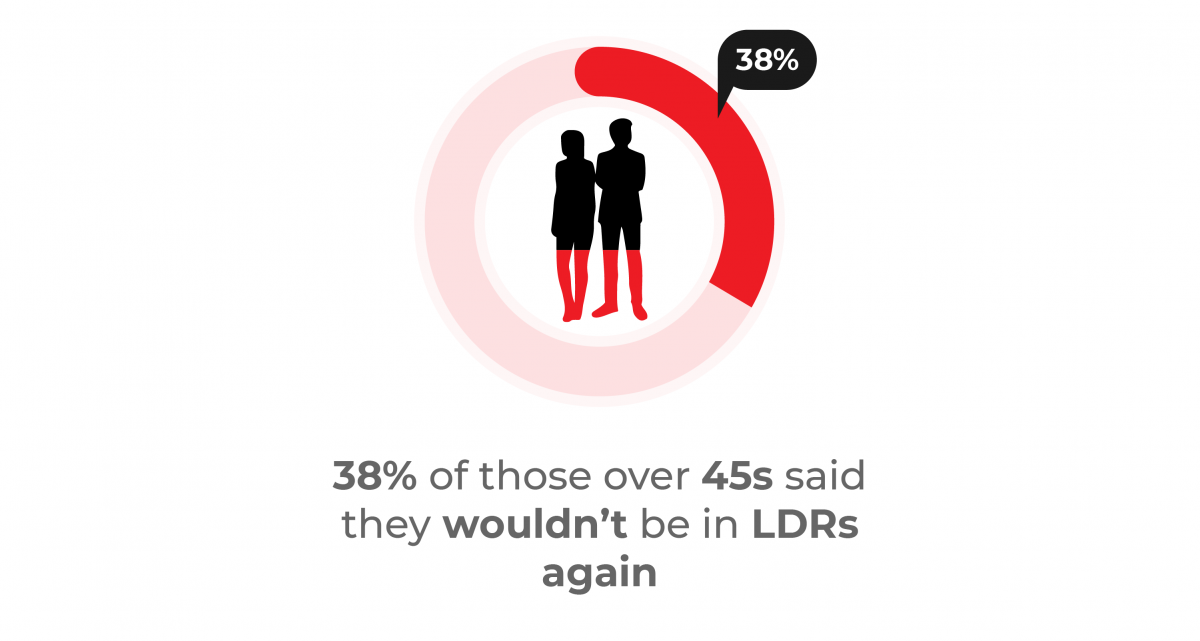
This suggests that older people don’t want to spend long periods of time apart from their significant others, at least as much as young people.
According to a YouGov poll from 2018, 38% of those aged 55 or older7 agreed with the statement “Out of sight, out of mind” when it came to long-distance relationships, suggesting that they were not as interested in maintaining them as younger people on the whole.
It makes sense given that 18-24-year-olds are much more likely to be in college, which is one of the major reasons for long-distance. And since they’re studying, they might feel like they have less time to date anyway.
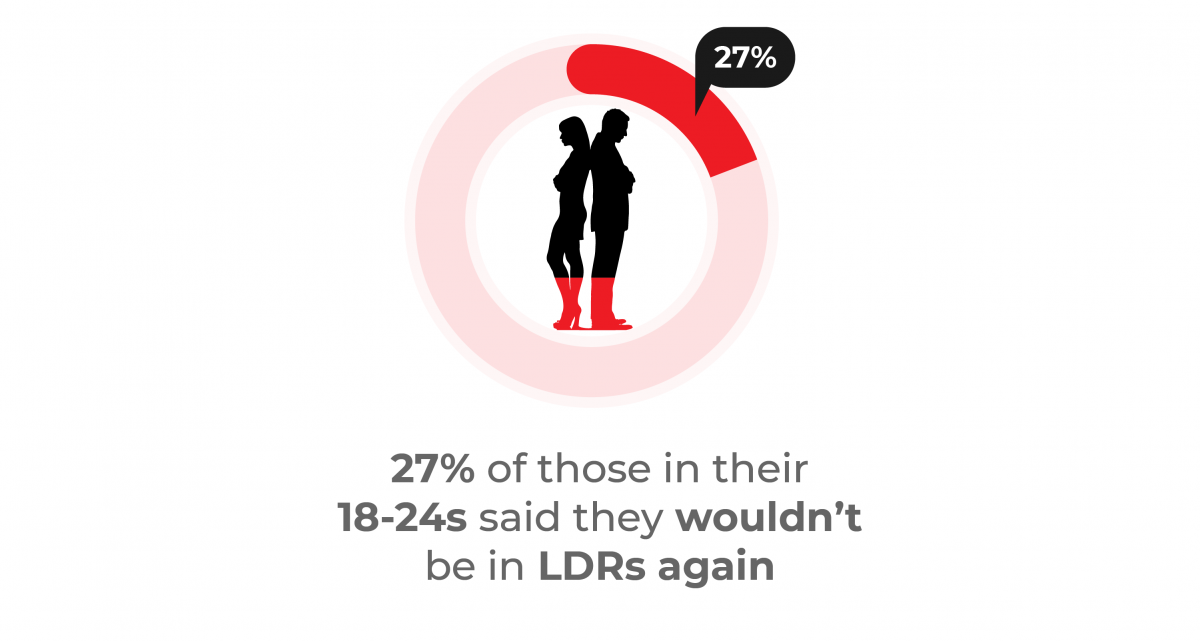
Whereas those aged 45 and older might feel like there’s not much point in wasting time. They might have more freedom to move and be with the people they care about in person.
So the reasons behind it could be practical rather than sentimental.
How Far Do Couples Have To Be So It Can Be Called a “Long-Distance Relationship”?
It seems like no one can agree exactly on what a long-distance relationship is exactly.
According to research, the average distance of a long-distance relationship couple is 125 miles (Easelly, 2019).1
Another survey of 600 respondents found that the longest-distance relationship title goes to a couple, one living in Xi’an, China, and the other in Santiago, Chile, a total distance of 12,371 miles (Atlas Obscura, 2016).8
The shortest distance from the same survey above found the shortest “long-distance relationship” distance was 41 miles (Atlas Obscura, 2016).8
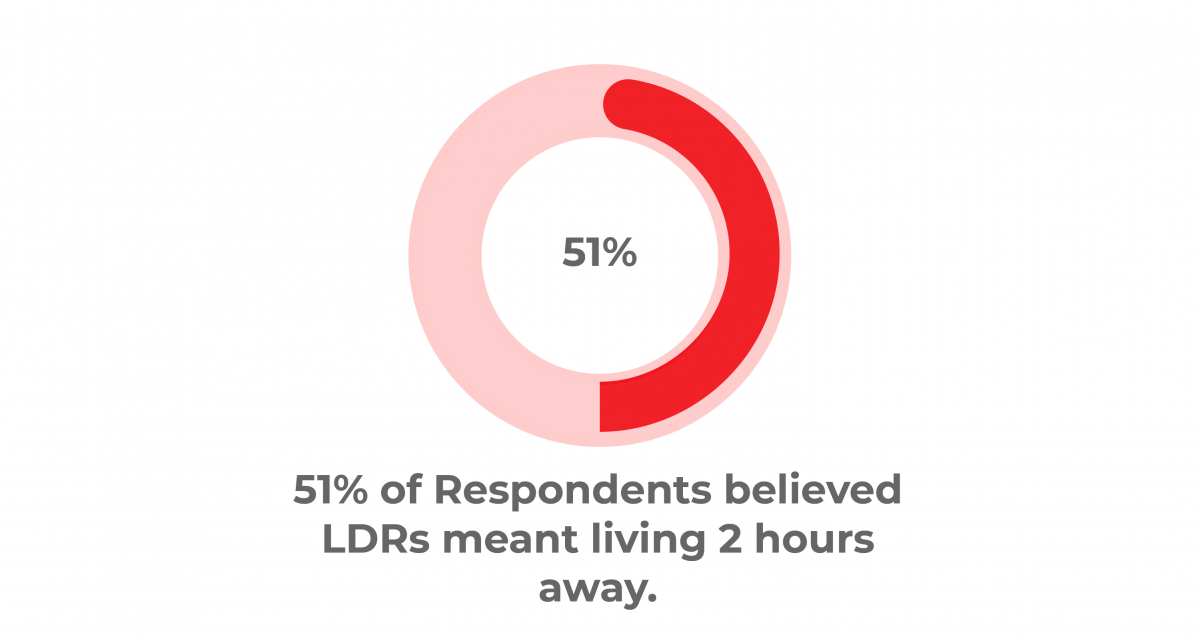
For this question, survey respondents could provide more than one answer, and many did (they can add their own too, but we didn’t find any surprising insights there). Percentages given for this finding mean how many respondents out of the total gave this answer.
For example, the top answer was “Living at least 2 hours travel distance away”, with 51% of respondents agreeing this was one way to define an LDR.

Answers to the question “What is necessary to call a relationship long-distance?” included:
- Living at least 2 hours travel distance away (51%)
- Living in a different state or country (50.8%)
- When you aren’t able to meet casually (26.2%)
- Need to plan meetings 2 or more weeks ahead (14.9%)
- When meeting creates a big financial burden (12.6%)
And even:
- When either person isn’t happy that way (just 1 disenchanted individual)
So it’s clear that while most people agree some level of geographical difficulty is involved, the exact limits of LDR are much harder to pin down.
How Many People Reported Cheating In Long-Distance Relationships?
. The image includes a circular chart with a segment representing 22% and silhouettes of a couple with one partner holding hands with another person.](https://sexualalpha.com/wp-content/uploads/2022/01/13-ldr-study-1200x641.png)
It’s notoriously difficult to get accurate information about cheating in relationships. Even in anonymous surveys, people don’t want to be honest all the time.
Some estimates place the number at over 70%9, but a study using data from the General Social Survey10 claimed a somewhat more comforting 16%.
22% of our respondents said that there was cheating in their relationship – either the respondent cheated, their partner did, or both.
Another 13.5% claimed they weren’t sure if their partner had cheated or not.
And in total, 58.5% of respondents were totally confident that no cheating occurred in their relationships.
That means long-distance probably does not significantly increase the likelihood of infidelity in relationships, which might be surprising to some.
What Is the Biggest Reason for Long-Distance Relationship Failure?
Long-distance relationships fail for a multitude of reasons – all of the reasons a proximal relationship can fail, along with a few that distance adds or exacerbates.
Kiiroo’s (2018)2 survey reported the following as the top 8 challenges faced in a long-distance relationship:
- Lack of Physical Intimacy — 66%
- Worried my partner would meet someone else — 55%
- Feel lonely — 50%
- Expensive to visit each other — 45%
- Growing apart — 43%
- Lack of communication — 40%
- Time difference — 33%
- Difference of opinion on mode of communication (call vs text etc.) — 24%
Moreover, if a long-distance relationship is not going to work out, then the average time of breakup is after 4.5 months (Easelly, 2019).1
Another in-depth study of 20 couples in 2004 listed three frequently-reported problem categories that caused strain in long-distance relationships when couples were physically together at certain times (Journal of Social and Personal Relationships, 2004).11 These were:
- Pressure for Quality/Positive Time (46.0%)
- Because of the time spent apart, couples feel more pressure to have a good time during the periods they do spend together in person.
- This time-sensitive pressure made them feel as if they were forced to do more fun and unusual things, so many of them felt as if they had to squeeze activities in in order to make time spent together feel more worth it.
- Network Negotiation (13.8%)
- Having limited face-to-face time meant that partners often neglected other personal relationships when they were physically with their significant others, which placed a strain on friendships and even family bonds on occasion.
- Constructs Unknowns (11.5%)
- Uncertainty and unknowns from spending time apart often made partners more uneasy when together in person due to factors like jealousy, conflicting aspects of personality, and confusion.
The same study reported more ways that couples time spent together could actually have negative influences on the relationship as a whole, including:
- Let down (40.7%)
- Partners reported that time spent together was often highly enjoyable, so much so that separating and going back to long-distance led to a feeling of being let down or disappointed whenever they were spending time apart.
- Face-to-face standards (20.9%)
- The interactions that take place when couples are apart are different to those when they are physically together. Couples found themselves comparing the quality of their interactions in these situations and reflected that the interactions when apart do not live up to the standards set when they were together.
- Segmentation (10.5%)
- Couples might even feel like they are leading two different lives. Because they do certain things when they are together and not while apart, they might begin to feel like they are experiencing life sporadically and disparately.
In our research, we found that Bad or Not Enough Communication was the single biggest cause of relationship failure for 40.2% of respondents.
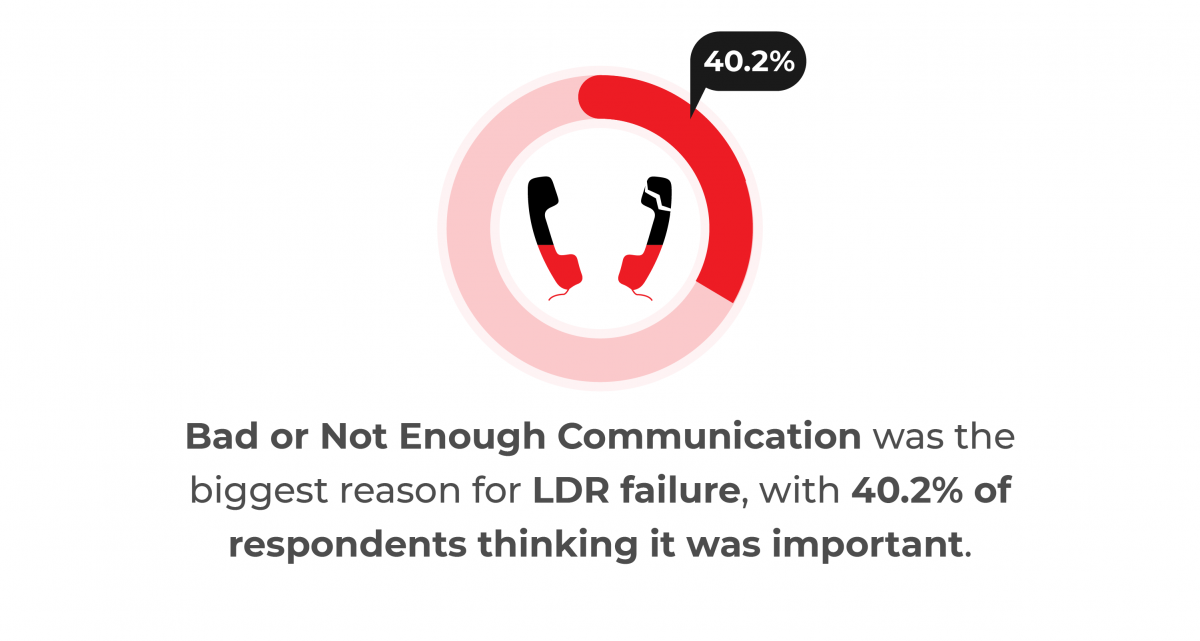
This was more than typical long-distance issues such as Lack of Intimacy or Physical Touch (33%) and Not Having an End Plan (30%).
Lack of communication was also considered a bigger issue than common problems in any relationship; namely Jealousy/Lack of Trust (28.7%) or even Cheating (17.5%).

This means that long-distance relationships frequently fail for the same reasons as proximal relationships, but they can be even harder to navigate successfully.
Dealing with Problems in Long-Distance Relationships
The challenges and difficulties faced by couples in LDR are somewhat different in nature to those faced by couples in proximal relationships, though there are fundamental similarities.
For example, maintaining sexual intimacy can be difficult in any relationship, regardless of distance, though the way these problems present themselves are different depending on the distance.
In proximal relationships, solutions can be anything from discussing fantasies and kinks to trying new things or even opening a relationship, but for long-distance, these are not solutions.
Instead, LDR couples should invest in ways to be intimate sexually from far away. Teledildonics and cybersex make this kind of intimacy more accessible and thrilling for long-distance couples, but it can be more simple methods such as sexting or talking dirty on the phone.
Communication is also a challenge. LDR couples have trouble organizing when and how to communicate at all.
One possible solution is to invest in hands-free headsets for phone conversations. That way, couples can talk to each other while having their hands free for other activities, so less time is needed to accomplish everyday tasks while also promoting feelings of intimacy.
Another important issue is discussing problems as they come up. It can be tempting to ignore such problems in LDR for the sake of keeping the relationship alive, but doing this does not solve anything. Viewing a relationship through a more objective lens, recognizing and discussing problems, and communicating honestly and openly are all crucial for keeping LDR alive.
How Many Long-Distance Relationships Are Open Relationships?

Since it’s harder for couples in long-distance to meet and be close to each other, one might expect a high proportion of open relationships, where partners are free to date or be intimate with others outside the primary relationship.
Open relationships are generally under-researched, but according to data pulled from the 2012 National Survey of Health and Sexual Behavior,12 approximately 4% of relationships are open in some way or another.
A study of 2,003 adults found that 2.4% of all adults, and 4% of adults currently in a relationship, were engaged in open relationships of some kind (The Journal of Sex Research, 2019).13
12% of adults in the same survey reported that an open relationship was their ideal relationship type, with men being more likely to state they preferred these kinds of relationships (The Journal of Sex Research, 2019).13
5.1% of our respondents claimed their long-distance relationships were open, similar to the National Survey data.
That means proximity doesn’t seem to have much of an effect on whether a relationship is open or not.
Which Age Group Is Most Likely To Be In An Open Relationship?
According to The Journal of Sex Research (2019),13 younger people are typically more likely to report and prefer being in open relationships. Most media coverage tends to agree with this trend, and it is likely that most people on the street would agree that this is true.
Interestingly, we found that older respondents were more likely to report open relationships.
8.8% of those aged 65 or older said they had open relationships, compared to 5.4% of 18-24-year-olds and just 4.4% of those between 25 and 34.
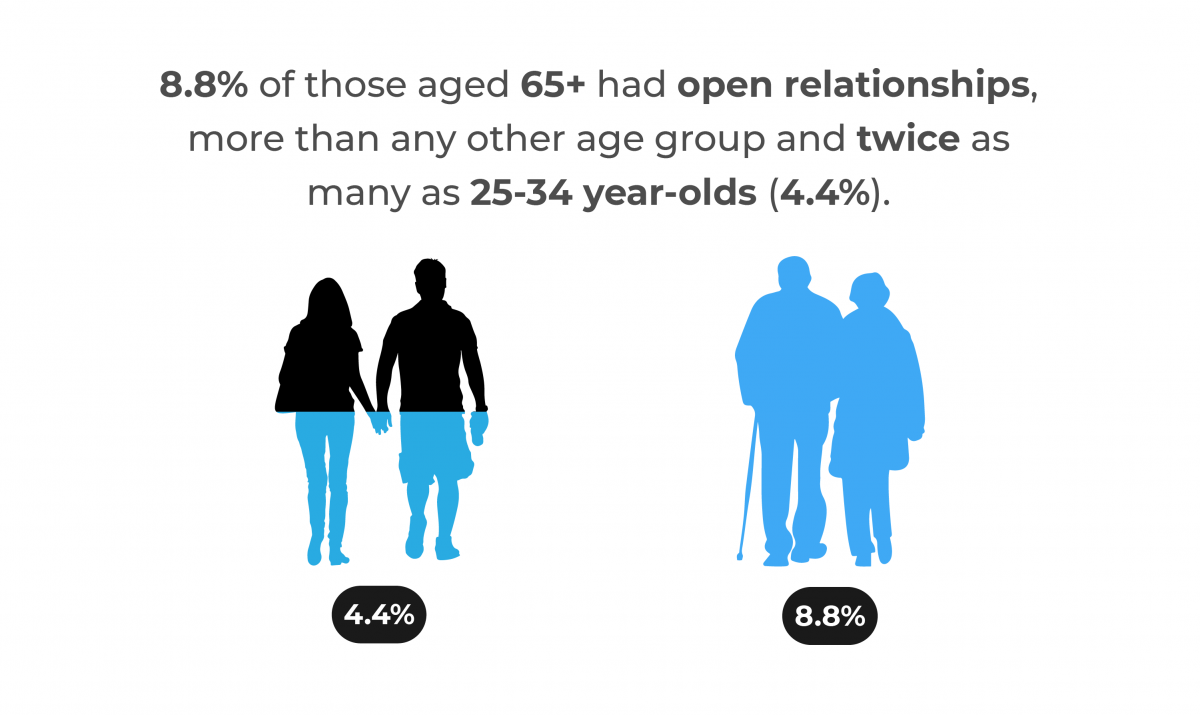
This goes against the conventional view that younger people are more open to non-monogamous relationships.
It’s important to remember that we were asking participants about historical relationships as well as current ones, so it is plausible that many or even most of these open relationships occurred in the past.
Given the reputation of the 1960s and 70s, when many of the older respondents would have been in college, one possible conclusion is that “free love” college students were more open and non-monogamous than their present-day counterparts.
Whatever the reason, it is clear that non-monogamous relationships are not a new phenomenon.
How Often Do Long-Distance Relationship Couples Meet?
In a study, partners in long-distance relationships reported the top 3 ways that the time they spent with one another had a positive influence on them in the long term (Journal of Social and Personal Relationships, 2004):14
- Rejuvenation (20.5%)
- Partners reported a sense of feeling recharged or refilled, having more energy and a renewed commitment.
- Reminder of the relationship/partner (19.2%)
- Getting a reminder of their partner’s presence helped them feel more connected and reminded them of why they are in their chosen relationship in the first place.
- Constructs Memories (19.2%)
- Building memories together and sharing experiences gives couples something to draw upon and reminisce about during their time apart.
On average, couples in long-distance relationships visit each other 1.5 times per month1, with planes being the most commonly utilized mode of transport.8
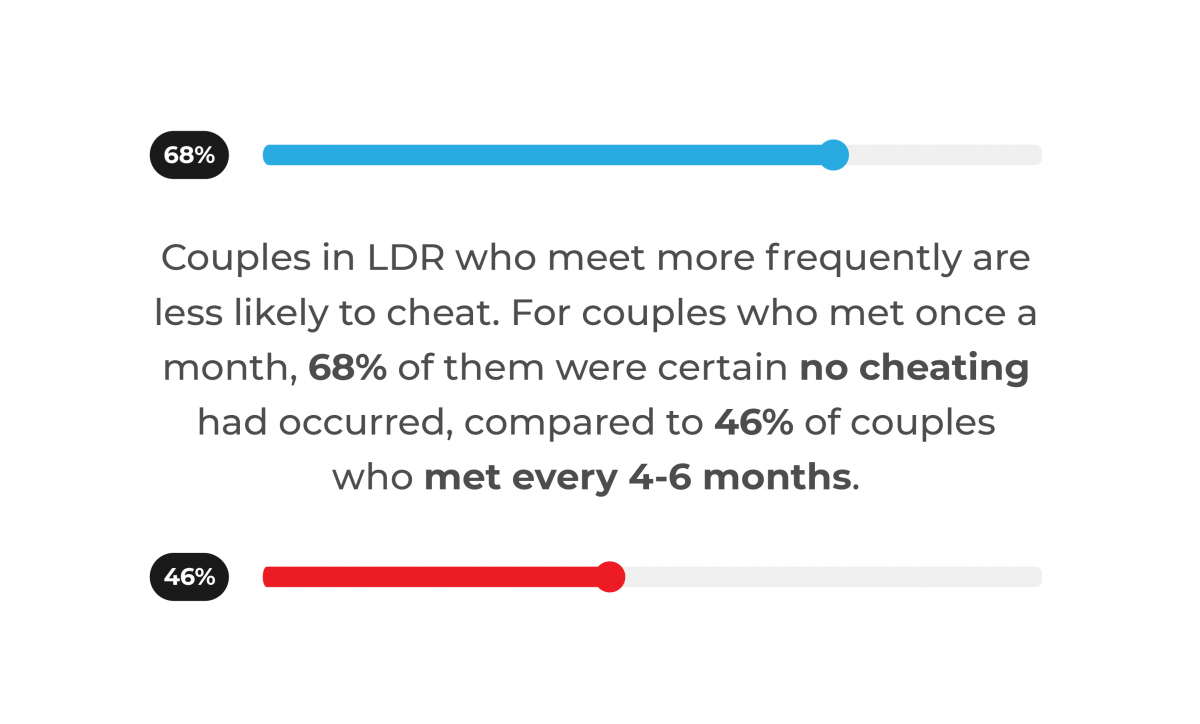
Cheating is one of the gravest causes of concern in any relationship. Victims of cheating are often left confused, hurt, and wondering what else they could have done.
For LDR couples at least, it seems that meeting more often makes cheating much less likely.
68% of couples who met at least once a month were certain no one in the relationship had been unfaithful.
Couples who met less frequently were more likely to report infidelity. For couples who met every 4-6 months, only 46% of them were confident no cheating occurred.
And for couples who had never met in real life, only 34% could confidently claim no infidelity occurred.
What Is the Biggest Reason for Entering Long-Distance Relationships?
39.8% of respondents said that work was the reason they entered into long-distance relationships. A survey of 600 couples also found work to be the most common reason for couples being apart (Atlas Obscura, 2016).8
Study came in as the second most common reason, with 31.4% of responses.
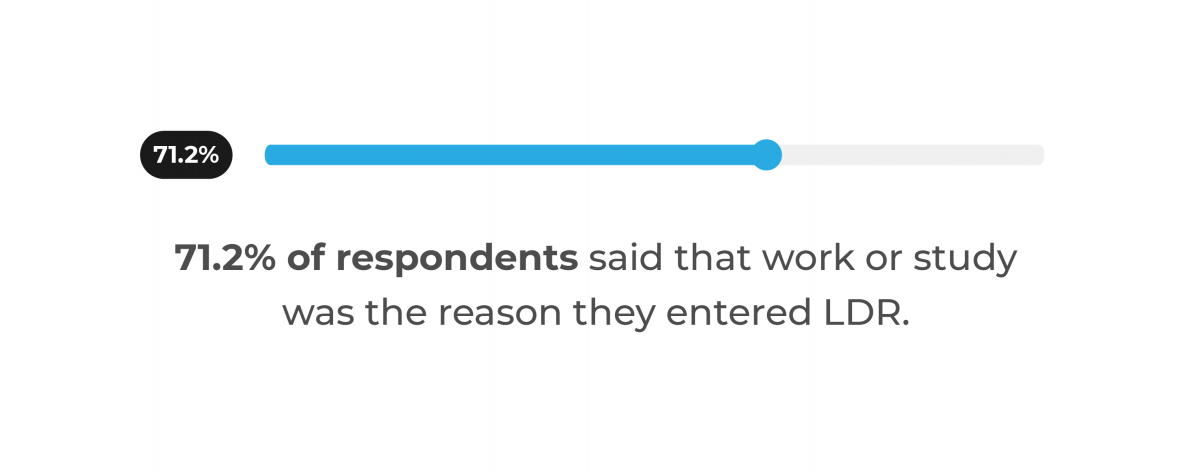
Note that “What’s the main reason why you are living (or did live) in LDR?” was a multiple-answer question – respondents could give as many responses as they felt was necessary.
Unsurprisingly, Studying was much more common for the 18-24 demographic, with 49.1% citing it as the reason for their relationship being long-distance. This age group was also the most likely to state they met online, with 23.7% of them giving this answer.
Despite being a famous and common media trope, only 0.6% of responses cited “Military” as a reason for their LDR.
In total, 17% of responses stated they met their partner online, no doubt aided by the prevalence of online dating and social media as resources to find romantic partners.
How Long Have People Been In Long-Distance Relationships?
There was a lot of variation in duration for LDRs, but on the whole, it seems people can be very patient when it comes to closing the distance.
A survey of 600 couples found that the longest long-distance relationship time-wise lasted 44 years, and several others in the same survey had been going for over 30 (Atlas Obscura, 2016).8
However, shorter durations are far more prevalent. 12% of couples in one US survey were in a long-distance relationship for 3 to 6 months, and another 12% were in them for between 1 and 2 years (Statista, 2016).15
Going back to the Journal of Social and Personal Relationships (2004)11 study, many couples report that time spent apart can improve the time spent together and the relationship as a whole, making them potentially reasons why people remain long-distance for so long. The top three frequently discussed characterizations were:
- Fosters Quality Time (27.3%)
- Planning and desiring to spend quality time when together can make couples appreciate the time they spend in each others’ company more pleasant and attractive in the future.
- Segmentation (18.2%)
- Doing activities such as work when apart lets them spend more devoted time to each other when together, so the time together can be more appreciated and “efficient”; that is, there can be fewer distractions.
- Excitement (16.5%)
- Couples reported that being apart made them more excited for the next time they saw each other. They felt more grateful for the time they shared, and it made them feel happy to think about and to have something to look forward to.
50.8% of respondents stated that they lived in an LDR for more than a year. 30.6% were in such relationships for 2 years or more, with one answer stating they were in such a relationship for 21 years and since closed the distance.
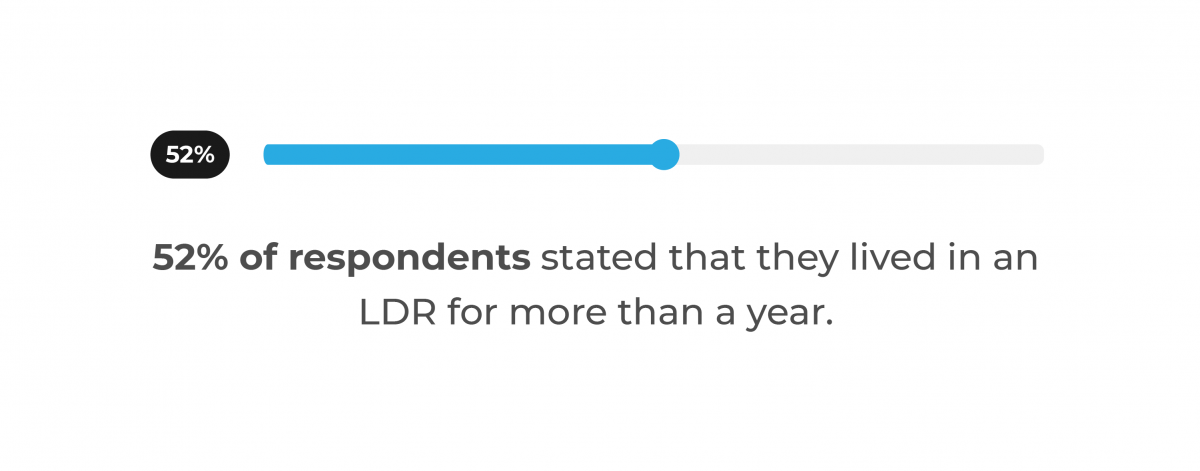
Of the respondents who spent more than 2 years long-distance, 30% had since closed the distance – similar to the overall number who had closed. So spending a longer time apart is not an indicator that the relationship is doomed.
Perhaps, on the contrary – a longer-term commitment to long-distance could mean that couples are more willing to make sacrifices for each other and be patient in the long term, an important part of any successful relationship.
How Many People Have Never Met Their Partner In-Person?
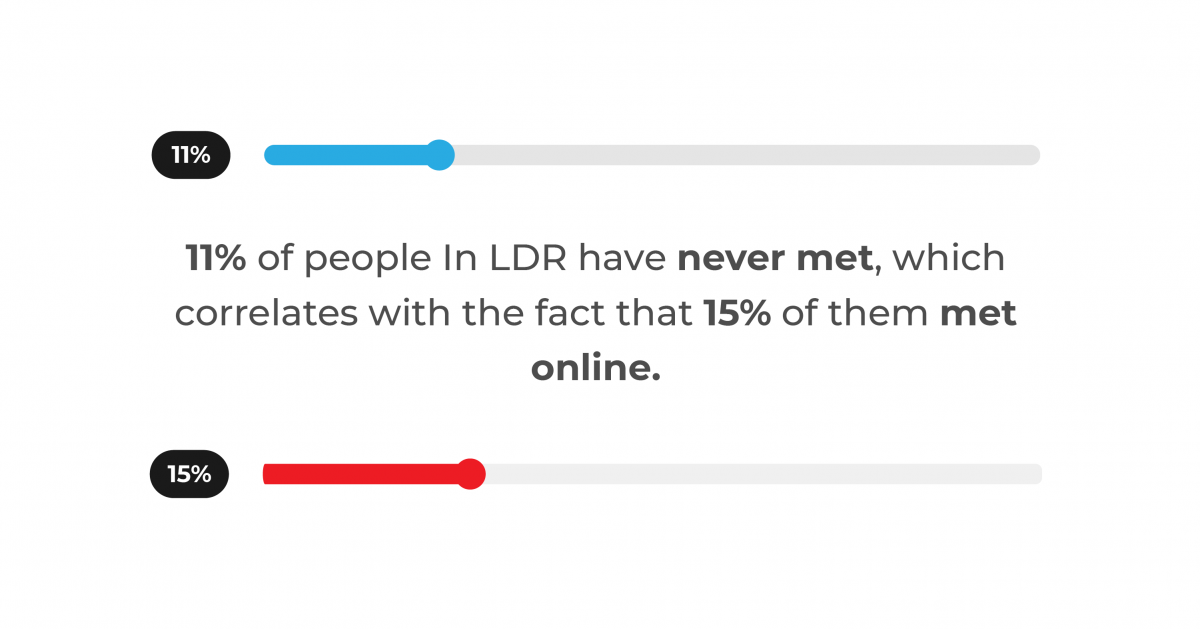
Most people would probably agree that physical closeness is important for bonding in relationships.
On the other hand, the proliferation of social media necessarily means that couples meeting online are more common than ever.
So it may or may not be surprising that 11% of respondents had never met their LDR partners in real life.
What is likely more surprising is that these respondents were not much more likely to have had their relationships fail. Out of those who never met their partner in real life, 26.6% stated they were “single right now” or “broke up” to question 7 (do you plan to close the distance?).
This is not significantly higher than the proportion of respondents who met their partners more than once a month and were “single right now” or “broke up” (24.6%).
How Many People Have Never Been In A Long-Distance Relationship?
With contemporary technology and the increasing demand to work and study abroad, long-distance relationships are increasing.

So it might be a surprise to learn that out of the 7392 respondents surveyed, 75.5% of them had never had a long-distance relationship.
A Statista (2016)15 survey reported that 38% of respondents had never been in a long-distance relationship, less than half the figure we found in our research.
Out of the total, only 8.1% had been in an LDR and closed the distance.
(We did not ask respondents who replied “no, I have never lived in a long-distance relationship” any further questions, so they have been excluded from the remainder of our findings.)
LDRs became less prevalent as respondents got older, with 80.5% of 45-year-olds and older saying they had never been in one. For those younger than 45, the figure was 72.9%.
So LDRs are still uncommon despite the ever-developing ecosystem of technology to facilitate such relationships.
Conclusion
We’d like to hear from you. What was your #1 takeaway from this research? Did one of our findings surprise you?
Or perhaps you have a question you’d like to know more about this or the some other relationship statistics.
Either way, let us know in the comments.
And here’s the link if you want to investigate the raw data yourself.
And finally the full infographic; feel free to embed it and share it.
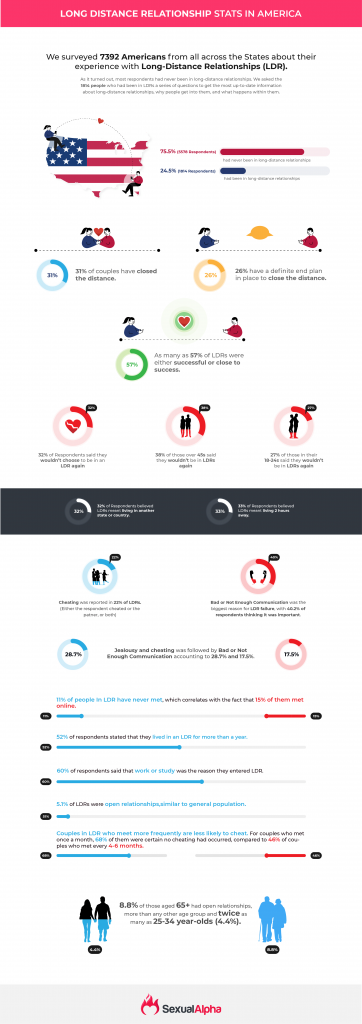
(Click to enlarge.)
Footnotes
- Easelly, 2019. An article on long-distance relationships statistics.
- KIIROO, 2018. An article on long-distance relationship troubles.
- Journal of American College Health, 2021. A study of 2,075 American college students.
- Fatherly, 2018. An article on the divorce rate in America.
- Friendship Lamps, 2020. An article on long-distance relationship statistics.
- New York Post, 2018. An article on long-distance relationships success rate.
- YouGov, 2018. A survey of 8,814 U.S. adults.
- Atlas Obscura, 2016. A survey of 600 respondents.
- Sage Journals, 1999. A research article authored by Michael W. Wiederman and Catherine Hurd, experiences with extradyadic (ED) dating and sexual activity.
- Institute for Family Studies, 2018. An article on the demographics of infidelity in America.
- Journal of Social and Personal Relationships, 2004. A study of 20 American long-distance, heterosexual couples
- Springer Nature, 2018. Open Relationships, Nonconsensual Nonmonogamy, and Monogamy Among U.S. Adults: Findings from the 2012 National Survey of Sexual Health and Behavior.
- The Journal of Sex Research, 2019. A study of 2,003 Canadian adults.
- Journal of Social and Personal Relationships, 2004. A study of 20 American long-distance, heterosexual couples.
- Statista, 2016. A survey of 2,252 U.S. respondents.